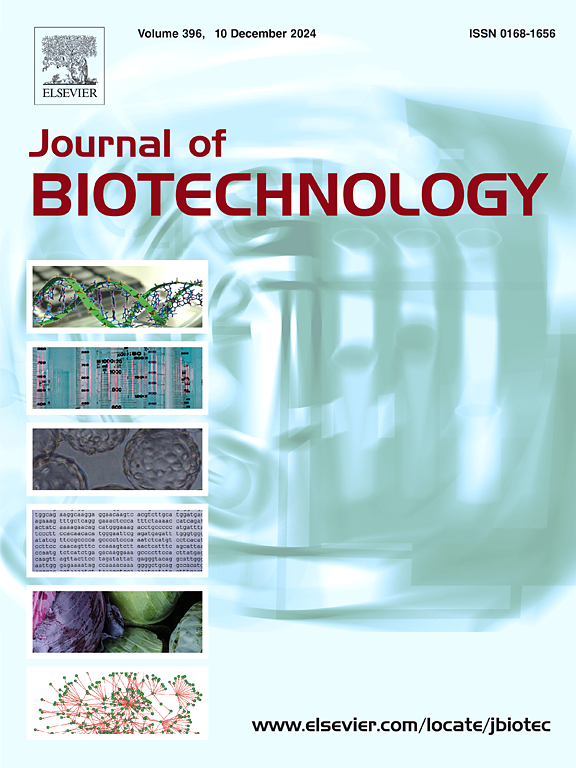Improving thermostability of α-L-fucosidase from Pedobacter sp. via consensus-guided engineering and directed evolution
IF 3.9
2区 生物学
Q2 BIOTECHNOLOGY & APPLIED MICROBIOLOGY
引用次数: 0
Abstract
The α-L-fucosidase from Pedobacter sp. (PbFuc), a glycoside hydrolase capable of catalyzing the synthesis of 2’-fucosyllactose (2’-FL) from 4-nitrophenyl α-L-fucopyranoside (pNP-Fuc) and D-lactose, exhibits limited industrial applicability due to inherent thermostability constraints. This study implemented a combinatorial strategy integrating consensus-guided engineering and directed evolution to engineer the thermal stability of PbFuc, resulting in the identification of six critical mutants (G53C, M54I, N59S, T71H, R125C, S199P) and the subsequent construction of the combinatorial mutant M6. Thermostability assays revealed complete inactivation of the wild-type enzyme after 30-min incubation at 45 °C, whereas M6 retained approximately 40 % residual activity under equivalent conditions at 60 °C, accompanied by an increase in the optimal reaction temperature from 35 °C to 40 °C. Structural mechanism analysis demonstrated that the enhanced thermostability of M6 originated from synergistic multilevel structural optimization and reorganization of molecular interaction networks: Conformational stabilization manifested through prolonged maintenance of stable secondary structural conformations during thermal stress and reduced amplitude of tertiary structural fluctuations; Global structural compaction decreased solvent-accessible surface area, thereby minimizing thermal energy transfer; Local structural reinforcement occurred via the formation of novel hydrogen bonds, enhanced rigidity through π-π stacking, and neutralization of electrostatic repulsion via charge compensation.
通过共识导向工程和定向进化提高Pedobacter sp. α-L- focusidase的热稳定性。
来自Pedobacter sp.的α-L- focusidase (PbFuc)是一种糖苷水解酶,能够催化4-硝基α-L-fucopyranoside (pNP-Fuc)和d -乳糖合成2'- focusyllactose (2'- fl),由于其固有的热稳定性限制,其工业适用性有限。本研究采用共识引导工程和定向进化相结合的组合策略来设计PbFuc的热稳定性,从而鉴定出6个关键突变体(G53C、M54I、N59S、T71H、R125C、S199P),并随后构建了组合突变体M6。热稳定性测试显示,野生型酶在45°C下孵育30分钟后完全失活,而M6在同等条件下在60°C下保留了大约40%的剩余活性,同时最佳反应温度从35°C增加到40°C。结构机理分析表明,M6的热稳定性增强源于分子相互作用网络的协同多层结构优化和重组:构象稳定表现为热应力期间二级结构构象的长时间维持稳定,三级结构波动幅度减小;整体结构压实减少了溶剂可达表面积,从而最大限度地减少了热能传递;通过形成新的氢键,通过π-π堆叠增强刚性,以及通过电荷补偿中和静电斥力,局部结构得到增强。
本文章由计算机程序翻译,如有差异,请以英文原文为准。
求助全文
约1分钟内获得全文
求助全文
来源期刊

Journal of biotechnology
工程技术-生物工程与应用微生物
CiteScore
8.90
自引率
2.40%
发文量
190
审稿时长
45 days
期刊介绍:
The Journal of Biotechnology has an open access mirror journal, the Journal of Biotechnology: X, sharing the same aims and scope, editorial team, submission system and rigorous peer review.
The Journal provides a medium for the rapid publication of both full-length articles and short communications on novel and innovative aspects of biotechnology. The Journal will accept papers ranging from genetic or molecular biological positions to those covering biochemical, chemical or bioprocess engineering aspects as well as computer application of new software concepts, provided that in each case the material is directly relevant to biotechnological systems. Papers presenting information of a multidisciplinary nature that would not be suitable for publication in a journal devoted to a single discipline, are particularly welcome.
 求助内容:
求助内容: 应助结果提醒方式:
应助结果提醒方式:


